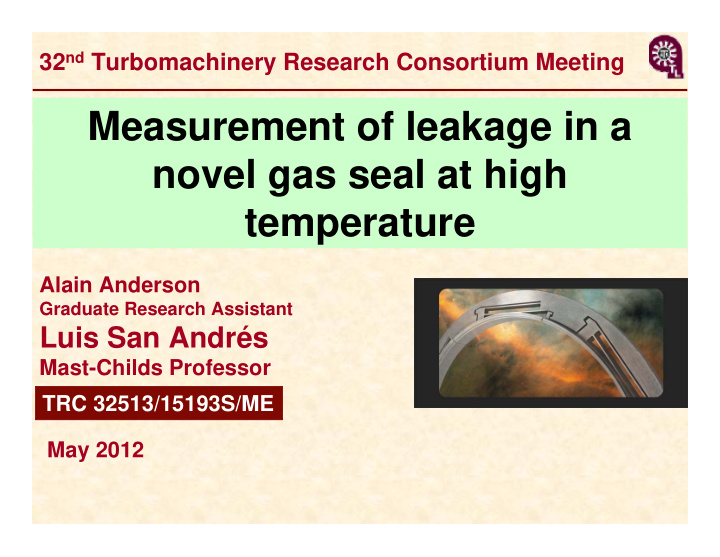



32 nd Turbomachinery Research Consortium Meeting Measurement of leakage in a novel gas seal at high temperature Alain Anderson Graduate Research Assistant Luis San Andrés Mast-Childs Professor TRC 32513/15193S/ME May 2012
Justification Trends in High Performance Turbomachinery - More compact units (reduce axial length) - Extreme operating temperatures and pressures - More efficient & reliable Issues of Importance Source: Siemens - Reduce parasitic leakage - Reduce specific fuel consumption & COST - Increase power delivery - Eliminate potential for rotordynamic instability
TRC project objectives Two year program (2010-12) - Conduct leakage tests with a HALO TM seal and a three teeth labyrinth seal at - High temperatures (300°C) and high surface speeds (120 m/s: 15 krpm) Outcomes - Enable the application of new sealing technology - Increase system efficiency Reduce leakage - - Eliminate wear of components Extend maintenance intervals -
HT seal test rig HOT AIR EXHAUST DUCT AIR OUT 1 7 Quill shaft Tapered roller Air gas Constant 287 J/kg-K bearings 2 Shaft 8 Flexible coupling Supply Pressure, P s 1.01 – 9.09 bar 3 Disk 9 Test seal Inlet Temperature, T s 298 K - 573 K 4 Pressure vessel 10 Metal Mesh Foil Bearing Exhaust Pressure, P a 1.01 bar 5 Air inlet 11 Position rods Eddy current sensors Ambient Temperature, T a 298 K 6 Motor 12 (X and Y directions)
HT seal test rig Hot air inlet 100 psig MAX Eddy current sensors Bearing assembly Shaft MMFB Journal Disk Test seal
Test seals Labyrinth Seal 3 teeth Cantilever pad HALO TM Seal
Test seals Disk Material 4140 Steel 12.3 10 -6 / ° C Coefficient of Thermal Expansion Outer Diameter 166.85 mm Disk Thickness 44.45 mm HALO TM Seal Labyrinth Seal Material 4140 Steel Material 4140 Steel 12.3 10 -6 / ° C Coefficient of Thermal Expansion Coefficient of Thermal Expansion 12.3 10 -6 / ° C Outer Diameter 183.05 mm Outer Diameter 183.11 mm Inner Diameter (Upstream) 167.28 mm Inner Diameter 167.35 mm Inner Diameter (Downstream) 167.10 mm Axial Length, l 8.40 mm Axial Length 8.48 mm Number of Teeth 3 Pad Allowable Radial Movement 0.27 mm Teeth Tip Width 0.17 mm Pad Axial Length, l 8.05 mm Pad Arc Length (40 ° ) 58.42 mm Cavity Depth 3.0 mm Number of Pads 9 Diametral Clearance 0.49 mm Beam Axial Width 6.40 mm Diametral Clearance 0.43 mm
The HALO TM seal Hydrostatic Advanced LOw Leakage Seal All metal non-contacting seal Upstream P a P s Flow
LEAKAGE: Labyrinth seal Flow rate decreases with gas temperature due to: surfaces thermal expansion lower air density higher viscosity No rotational speed
LEAKAGE: HALO TM seal HaLO’s leakage is a fraction of labyrinth seal. Seal can withstand higher pressures. No rotational speed
Leakage Comparison: two seals Labyrinth seal HALO TM seal HALO seal has ~ 1/5 of the leakage in a labyrinth seal with ~ same clearance
Flow Factor Comparison: two seals Labyrinth m T seal P D s HALO TM seal No rotational speed Flow factor removes effect of temperature and seal size. HALO seal is very effective at high pressures because it is a controlled clearance seal.
TRC project current status In progress: • Leakage tests with both seals: rotation up to 3 krpm • Estimations of drag power loss • Timely modifications for operation at high rotor speed (12 krpm) await a new student Questions (?)
Recommend
More recommend